Letters from Lodi
An insightful and objective look at viticulture and winemaking from the Lodi
Appellation and the growers and vintners behind these crafts. Told from the
perspective of multi-award winning wine journalist, Randy Caparoso.
What is Lodi terroir? (part 2: Mediterranean Climate)
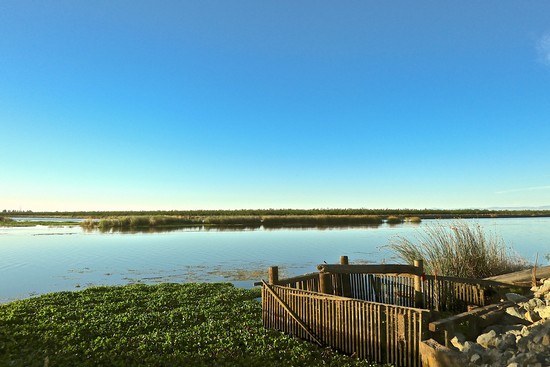
Delta slough alongside vineyards located on the far west side of the Lodi AVA, where most of the region's terroir falls below sea level and is first to be cooled off by daily Delta breezes blowing in from the Bay Area.
Continued from What is Lodi terroir? (Part 1, Definition)
Impact of Delta breezes on Lodi terroir
Because it falls within a watershed immediately east of the Sacramento-San Joaquin River Delta draining directly into San Pablo Bay (the northern extension of San Francisco Bay), the terroir of entire Lodi Viticultural Area in terms of climate is defined as "Mediterranean," a climate classification also comparable to much of the coastal wine regions of California.
Mediterranean climate is characterized by dry summers and mild, wet winters typical of wine regions located 30 to 45 degrees north or south of the equator. This includes, of course, almost all the wine regions along the Mediterranean Basin, as well as much of the California Coast between the North Coast and Central Coast AVAs.
While Lodi is not located directly on the coast, the region sits between the inland seaport cities of Sacramento and Stockton, fed by waterways deep enough for ocean going vessels. Lodi's Mediterranean climate is primarily the result of California's famous Delta breezes: The direct influence of the cool air moving in from the Bay Area through the coastal mountain gap (much of it below sea level) of the California Delta.

Besides allowing grapevines to rest and replenish with ample rain during winter months, the advantage of a Mediterranean climate for the Lodi winegrowing industry is that bone-dry summer conditions and steady breezes help to optimize grape growing by minimizing potential issues such as rot and mildew in grapes.
Another key component of Lodi's Mediterranean climate is the region's diurnal temperatures: The variation of highest to lowest temperatures within a given day, reflecting day/night temperature swings. Diurnal swings are one of the key distinguishing factors of the Mediterranean climate common to virtually all of California's winegrowing regions, particularly the coastal areas between the North Coast and the Central Coast, and also typifying the Sierra Foothills AVA east of Lodi.
Generally speaking, in regions averaging night temperatures close to or below 55° F. during growing season days, even with day temperatures averaging 80° F. to 90° F., grapes have the opportunity to achieve high phenolic and sugar ripeness in combination with good balancing acidity. The result is fresh, vivid fruit profiles, translating from grapes to wines.
In the following 100-year snapshot, Lodi's average diurnal swings are compared to that of five other major California wine regions. While the highs and lows in Lodi are marginally higher than in regions closer to the coast, the appellations bearing the closest resemblance in terms of growing season temperatures are Napa Valley and Sonoma County:
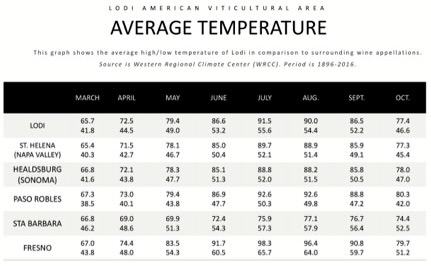
Lodi terroir in terms of Winkler scale climate classification
Temperatures alone, of course, do not describe any wine region's climate. In the winegrowing industry, the Winkler scale of growing degree days is probably the most constantly cited way of defining climate zones. In his April 2015 paper entitled Spatial Analysis of Climate in Winegrape Growing Regions in the Western United States, Linfield College Research Climatologist Gregory V. Jones demonstrated the minimum as well as maximum degree-day readings of West Coast wine regions.
A snapshot of the GDD (i.e. Growing Degree Days) of some of the regions analyzed in Jones' study:
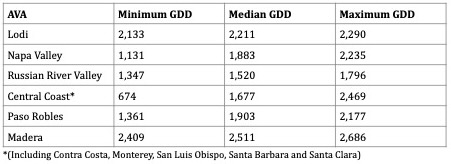
In Jones’ index, Lodi is predominantly and consistently a Region IV, while falling in the lower range of Region V just 22% of the time — despite being easily the most widely planted wine region in the U.S. (around 100,000 acres, or about as much as Napa Valley and Sonoma County combined).
By comparison, Napa Valley’s 43,000 or so acres of wine grapes are planted in no less than five different degree-day classifications, ranging from cool Region I to hot Region V. Napa Valley is a prime example of what Jones calls a “spatial variability.”

Research climatologist Gregory V. Jones in his element—vineyards up and down the West Coast.
Writes Jones, the Napa Valley AVA "reveals that it is predominantly Region III (56%) and Region IV (30%).” Jones’ research also finds that Paso Robles (about 40,000 planted acres) “spans three Winkler regions... Region II, III and IV (14%, 49% and 37% respectively).” In comparison, the much warmer Madera AVA (about 38,000 acres of wine grapes) “is largely a hot climate type... a Region V in GDD (100%).”
Hence, in the original Federal Register document submitted for government approval of an official Lodi AVA, finalized in 1986, a summary of the region's major climatic influence was borrowed from a 1937 USDA Soil Survey of the Lodi Area, saying: "Owing to its location opposite the wind gap leading inland from the Golden Gate, the range in temperature is narrower than in more northerly and southerly parts of the great valley [i.e. Central Valley]."
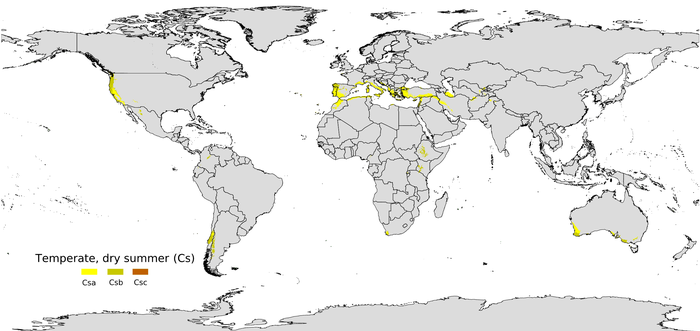
Kôppen climate classification notating Mediterranean climate zones around the world.
Lodi terroir in terms of Köppen classification and impending climate change
Since the 1950s, most of the wine world has used a climate classification system called Köppen–Geiger⏤or just Köppen climate classification⏤originally devised in 1884 by a German-Russian climatologist named Wladimir Köppen.
In this system, regions such as the Lodi AVA are classified as Csa, which is defined as a Hot-summer Mediterranean climate. By comparison, parts of Napa Valley and Sonoma County are also classified as having a Csa climate, while other parts of Napa Valley and a bigger chunk of Sonoma County are classified as Csb, or Warm-summer Mediterranean climate. In layman's terms, Csb is considered a slightly cooler climate than Csa.
Earlier in 2024, a team of climatologists led by Gregory V. Jones published a revision of the Köppen classifications entitled Historic Changes and Future Projections In Köppen-Geiger Climate Classifications in Major Wine Regions Worldwide. Its purpose, as you might surmise, is to give a better accounting of the rising temperatures taking place over the past 50 years⏤otherwise known as climate change⏤as well as to make some hard-nosed, science-based projections of what wine regions all around the world should expect over the next 20 to 40 years.

Comparison of similar regions in respect to their Mediterranean climate terroirs with maritime influence: Provence (top) and Lodi.
Two years ago, as it were, Professor Jones wrote to me to clarify what he and his researchers had already found, particularly about C Temperature climate zones defining Lodi and other regions up and down the California coast. Wrote Jones: "Using the updated Köppen-Geiger gridded data, we have found that the midlatitude C climates make up roughly 55 percent of the world’s defined wine growing regions. However, Mediterranean climate types (Csa, Csb) only make up roughly 15 percent of the surface area of wine regions globally."
In other words, according to Jones, Csa and Csb climate zones of the sort found in Lodi and much of California are far less extensive on a global winegrowing scale than commonly thought.
According to Jones' latest research, however, global warming has literally been changing the writing on the wall. It's coming hard and fast, and is bound to change both viticulture and wines around the world in ways that could probably be described as "drastic."
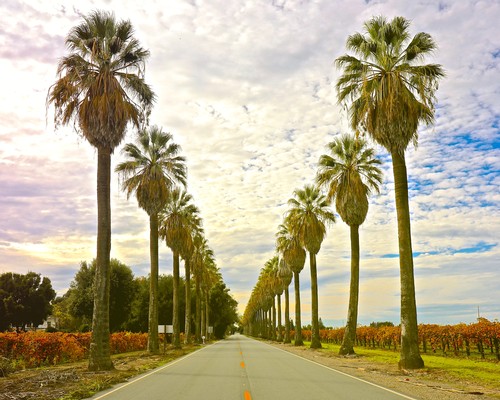
California fan palms originally planted in 1887 in Lodi's Acampo area, indicative of the region's healthy terroir marked by a warm to hot Mediterranean climate.
Lifting passages directly from the paper:
Recent research has shown that climate change is already affecting viticulture and wine production through changes in grapevine phenological development, harvest dates, and grape acidity and sugar content. However, establishing relationships between environmental changes and other components, like polyphenols or aroma compounds, is more complex. This research has added to the baseline knowledge of the potential changes of climate on viticulture and wine production by examining global and regional-scale shifts in the KG climate types for wine regions.
The main climatic shifts identified in this study are: Regions shifting to a warmer and drier climate (temperate warm-summer Mediterranean (Csb) to temperate hot-summer Mediterranean (Csa); dry semi-arid cold (BSk) to dry semi-arid hot (BSh) and arid hot desert (BWh) climates); and (2) other regions shifting to a warmer and moister climate (temperate oceanic (Cfb) to humid subtropical (Cfa)).
At the cool limits of viticulture, warming and shifting to more suitable climate types identified in this research will likely increase the potential ripening of the main varieties being grown today and expand the range to other varieties.

Grape varieties ideally suited to warm to hot Mediterranean climates such as Lodi's: Grenache noir, Syrah, Cinsaut and Mourvèdre.
Wine regions of the west coast of the USA are mostly projected to transition from a temperate warm-summer Mediterranean (Csb) to a temperate hot-summer Mediterranean (Csa) climate type, like what is projected in the IP, while in California, dry arid hot climate types (BWh-desert) are expected to increase, reflecting that the summers are expected to be much hotter.
In other words, according to Jones and his team, present-day "cooler" climate regions such as much of the Sonoma Coast and the Central Coast (from Santa Barbara to Monterey) are all projected to transition to Csa (i.e., Hot-summer Mediterranean climate), similar to Lodi's. This will happen by 2041, less than 20 years from now. As Jones underlines:
Significant shifts in the most recognizable wine region climate type, Mediterranean, is likely to occur with projections showing that temperate warm-summer Mediterranean climate (Csb) areas decline from over 9% to close to 1%, while temperate hot-summer Mediterranean climate (Csa) areas increase from around 10% to just over 17% from the recent past to mid-century.
Ready or not, according to these studies, global warming will be kicking down the doors of many of California's wine regions⏤despite the fact that Lodi's climate, or terroir in respect to climate, will remain pretty much the same!
Our next Lodi Wine post: What is Lodi terroir? (Part 3: Soil and topography)

Fiano harvest in Lodi's Mokelumne River AVA; one of many grapes ideally suited to warm to hot climates of the coming future.